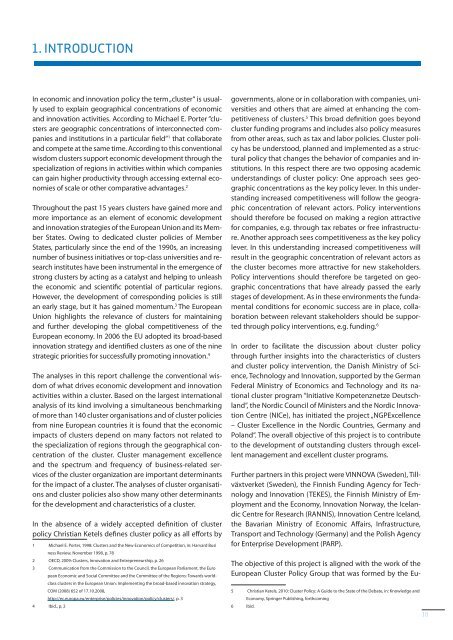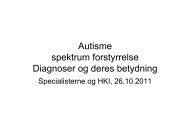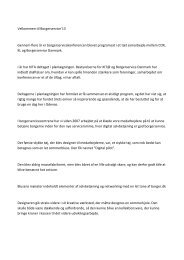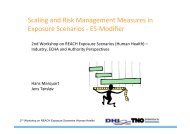Clusters are individuals - VDI/VDE-IT
Clusters are individuals - VDI/VDE-IT
Clusters are individuals - VDI/VDE-IT
You also want an ePaper? Increase the reach of your titles
YUMPU automatically turns print PDFs into web optimized ePapers that Google loves.
1. INTRODUCTION<br />
In economic and innovation policy the term „cluster“ is usually<br />
used to explain geographical concentrations of economic<br />
and innovation activities. According to Michael E. Porter “clusters<br />
<strong>are</strong> geographic concentrations of interconnected companies<br />
and institutions in a particular field” 1 that collaborate<br />
and compete at the same time. According to this conventional<br />
wisdom clusters support economic development through the<br />
specialization of regions in activities within which companies<br />
can gain higher productivity through accessing external economies<br />
of scale or other comparative advantages. 2<br />
Throughout the past 15 years clusters have gained more and<br />
more importance as an element of economic development<br />
and innovation strategies of the European Union and its Member<br />
States. Owing to dedicated cluster policies of Member<br />
States, particularly since the end of the 1990s, an increasing<br />
number of business initiatives or top-class universities and research<br />
institutes have been instrumental in the emergence of<br />
strong clusters by acting as a catalyst and helping to unleash<br />
the economic and scientific potential of particular regions.<br />
However, the development of corresponding policies is still<br />
an early stage, but it has gained momentum. 3 The European<br />
Union highlights the relevance of clusters for maintaining<br />
and further developing the global competitiveness of the<br />
European economy. In 2006 the EU adopted its broad-based<br />
innovation strategy and identified clusters as one of the nine<br />
strategic priorities for successfully promoting innovation. 4<br />
The analyses in this report challenge the conventional wisdom<br />
of what drives economic development and innovation<br />
activities within a cluster. Based on the largest international<br />
analysis of its kind involving a simultaneous benchmarking<br />
of more than 140 cluster organisations and of cluster policies<br />
from nine European countries it is found that the economic<br />
impacts of clusters depend on many factors not related to<br />
the specialization of regions through the geographical concentration<br />
of the cluster. Cluster management excellence<br />
and the spectrum and frequency of business-related services<br />
of the cluster organization <strong>are</strong> important determinants<br />
for the impact of a cluster. The analyses of cluster organisations<br />
and cluster policies also show many other determinants<br />
for the development and characteristics of a cluster.<br />
In the absence of a widely accepted definition of cluster<br />
policy Christian Ketels defines cluster policy as all efforts by<br />
1 Michael E. Porter, 1998: <strong>Clusters</strong> and the New Economics of Competition, in: Harvard Busi<br />
ness Review, November 1998, p. 78<br />
2 OECD, 2009: <strong>Clusters</strong>, Innovation and Entrepreneurship, p. 26<br />
3 Communication from the Commission to the Council, the European Parliament, the Euro<br />
pean Economic and Social Committee and the Committee of the Regions: Towards world-<br />
class clusters in the European Union: Implementing the broad-based innovation strategy,<br />
COM (2008) 652 of 17.10.2008,<br />
http://ec.europa.eu/enterprise/policies/innovation/policy/clusters/, p. 3<br />
4 Ibid., p. 2<br />
governments, alone or in collaboration with companies, universities<br />
and others that <strong>are</strong> aimed at enhancing the competitiveness<br />
of clusters. 5 This broad definition goes beyond<br />
cluster funding programs and includes also policy measures<br />
from other <strong>are</strong>as, such as tax and labor policies. Cluster policy<br />
has be understood, planned and implemented as a structural<br />
policy that changes the behavior of companies and institutions.<br />
In this respect there <strong>are</strong> two opposing academic<br />
understandings of cluster policy: One approach sees geographic<br />
concentrations as the key policy lever. In this understanding<br />
increased competitiveness will follow the geographic<br />
concentration of relevant actors. Policy interventions<br />
should therefore be focused on making a region attractive<br />
for companies, e.g. through tax rebates or free infrastructure.<br />
Another approach sees competitiveness as the key policy<br />
lever. In this understanding increased competitiveness will<br />
result in the geographic concentration of relevant actors as<br />
the cluster becomes more attractive for new stakeholders.<br />
Policy interventions should therefore be targeted on geographic<br />
concentrations that have already passed the early<br />
stages of development. As in these environments the fundamental<br />
conditions for economic success <strong>are</strong> in place, collaboration<br />
between relevant stakeholders should be supported<br />
through policy interventions, e.g. funding. 6<br />
In order to facilitate the discussion about cluster policy<br />
through further insights into the characteristics of clusters<br />
and cluster policy intervention, the Danish Ministry of Science,<br />
Technology and Innovation, supported by the German<br />
Federal Ministry of Economics and Technology and its national<br />
cluster program “Initiative Kompetenznetze Deutschland”,<br />
the Nordic Council of Ministers and the Nordic Innovation<br />
Centre (NICe), has initiated the project „NGPExcellence<br />
– Cluster Excellence in the Nordic Countries, Germany and<br />
Poland“. The overall objective of this project is to contribute<br />
to the development of outstanding clusters through excellent<br />
management and excellent cluster programs.<br />
Further partners in this project were VINNOVA (Sweden), Tillväxtverket<br />
(Sweden), the Finnish Funding Agency for Technology<br />
and Innovation (TEKES), the Finnish Ministry of Employment<br />
and the Economy, Innovation Norway, the Icelandic<br />
Centre for Research (RANNIS), Innovation Centre Iceland,<br />
the Bavarian Ministry of Economic Affairs, Infrastructure,<br />
Transport and Technology (Germany) and the Polish Agency<br />
for Enterprise Development (PARP).<br />
The objective of this project is aligned with the work of the<br />
European Cluster Policy Group that was formed by the Eu-<br />
5 Christian Ketels, 2010: Cluster Policy: A Guide to the State of the Debate, in: Knowledge and<br />
6 Ibid.<br />
Economy, Springer Publishing, forthcoming<br />
10

















